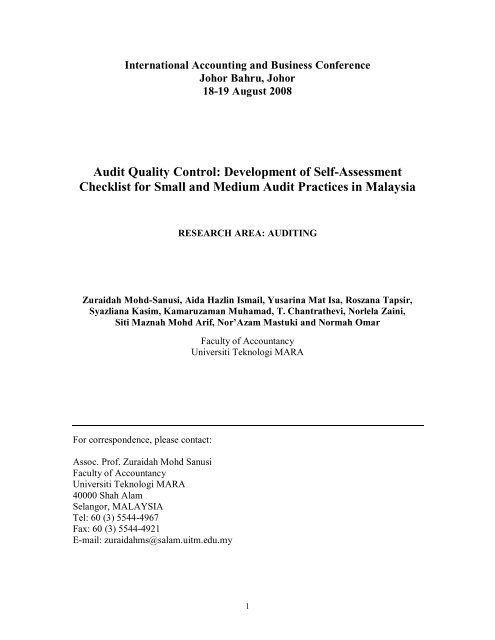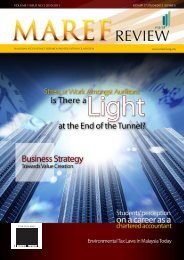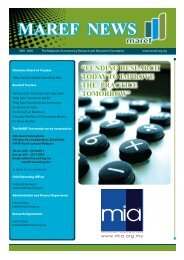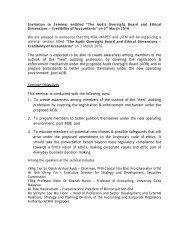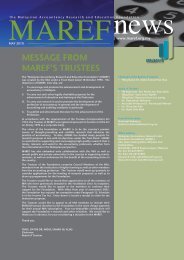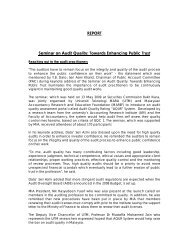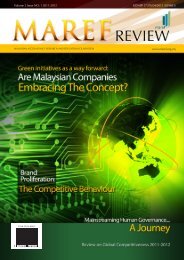Audit Quality Control: Development of Self-Assessment - Malaysian ...
Audit Quality Control: Development of Self-Assessment - Malaysian ...
Audit Quality Control: Development of Self-Assessment - Malaysian ...
Create successful ePaper yourself
Turn your PDF publications into a flip-book with our unique Google optimized e-Paper software.
<strong>Audit</strong> <strong>Quality</strong> <strong>Control</strong>: <strong>Development</strong> <strong>of</strong> <strong>Self</strong>-<strong>Assessment</strong>Checklist for Small and Medium <strong>Audit</strong> Practices inMalaysiaABSTRACTIn July 2006, the <strong>Malaysian</strong> Institute <strong>of</strong>Accountant (MIA) has adopted the ISQC 1 as part<strong>of</strong> the approved standard <strong>of</strong> auditing in Malaysia.In assisting the implementation <strong>of</strong> ISQC 1 amongaudit firms, a guideline on the ISQC 1requirement is essential. This paper providesinsights on the development <strong>of</strong> InternationalStandards on <strong>Quality</strong> <strong>Control</strong> 1 (ISQC 1) selfassessmentchecklist for small and medium auditfirms in Malaysia. The checklist is developedbased on ISQC1 requirements, ISQC 1 manualand MIA By-Laws. This checklist is also in-linewith ISQC 1 questionnaires prepared by othercountries such as Australia and Pakistan. It isthen validated by audit practitioners. It is hopedthat this audit quality system would assist thesmall and medium audit firms in improving andenhancing their audit service quality with theaspiration to be at par with the larger audit firms.Keywordsaudit quality, quality control system, ISQC 1, selfassessment,small and medium audit practices1.0 INTRODUCTION<strong>Audit</strong> quality is viewed as one <strong>of</strong> the importantfactors that affect the credibility <strong>of</strong> financialstatements (Arrunada, 2004). Users are morelikely to demonstrate high level <strong>of</strong> confidence onthe information presented in the financialstatements if the audit <strong>of</strong> the financial statementsis perceived to be <strong>of</strong> high quality. <strong>Assessment</strong> onaudit quality <strong>of</strong> audit firms ensures that an auditfirm’s processes are systematic and effective(Brinkley, 2006). <strong>Audit</strong>ing the auditors throughexternal evaluations is becoming a driving force<strong>of</strong> continuous improvement for the pr<strong>of</strong>ession(Brinkley, 2006). To compete successfully in thisenvironment, audit firms must continually striveto improve audit quality and hence, maximizeclient satisfaction.Recent development concerning audit qualitycontrol by International Federation <strong>of</strong> Accountant(IFAC) has required audit firms to comply withthe International Standards on <strong>Quality</strong> <strong>Control</strong>(ISQC 1). <strong>Malaysian</strong> Institute <strong>of</strong> Accountant(MIA) has, in July 2006, adopted the ISQC 1 aspart <strong>of</strong> the approved standard <strong>of</strong> auditing inMalaysia. In essence, ISQC 1 focuses on thequality <strong>of</strong> audit performed by the audit firms andthey are expected comply with the standard.Nevertheless, evidence showed that theimplementation to <strong>of</strong> ISQC 1 is rather limited in<strong>Malaysian</strong> small and medium audit firms (Omar& Johari, 2007). Small and medium audit firmstend to operate based on non-standard operatingprocedures, which essentially does not reflecttotal compliance to the ISQC 1.Based on the guidelines stated in the ISQC 1,compliance to the standard is perceived as highaudit quality. Although large audit firms havebeen argued and associated with high auditquality (DeAngelo, 1981), very limited studieshave measured audit quality using an objectivemeasure (Krishnan & Schauer, 2000). Paststudies have indirectly inferred that large auditfirms as a proxy for high audit quality (DeAngelo,1981; Carcello et al., 1992; Krishnan & Schauer,2000). However, it is still unclear how and whythe levels <strong>of</strong> audit quality differ among small andmedium firms. Hence, the objective <strong>of</strong> this studyis to assess the framework on efficiency andeffectiveness <strong>of</strong> the small and medium auditfirms. Subsequently, based on that framework,standards and benchmark information would bedeveloped.This study is hoped to contribute to theimprovement in the quality control <strong>of</strong> small andmedium audit practices in Malaysia. This study isnot aimed to strengthen the proposition that largeraudit firms deliver higher audit quality compare tothe smaller ones, but to provide a more objectiveappraisal <strong>of</strong> audit quality in small and mediumaudit firms. The self-assessment quality controlchecklist extends previous studies in thedevelopment <strong>of</strong> an objective measure. Thecurrent paper focuses on the first part <strong>of</strong> thisbigger study that highlights the development <strong>of</strong> asuitable checklist for the purpose <strong>of</strong> measuringaudit quality. The checklist would enable auditfirms to self-assess their service and to recognize2
any deficiency that could have compromised auditquality.2.0 LITERATURE REVIEW2.1 The Search for <strong>Audit</strong> <strong>Quality</strong>The demand for auditing services arises from aneed to facilitate dealings between the partiesinvolved in business relationships-shareholders,creditors, public authorities, employees andcustomers, etc (Arrunada, 2000). The accountingpr<strong>of</strong>ession has faced increasing pressure fromexternal parties to monitor and improve thequality <strong>of</strong> the audit process (Sutton, 1993). Thereare numerous <strong>of</strong> previous research done onstudying multi-aspects <strong>of</strong> audit quality. Thestrong interest in examining audit quality is partlydue to the concern <strong>of</strong> issues such corporatecollapse, expectation gaps and corporategovernance.One <strong>of</strong> the main areas in audit quality literature isthe association between audit quality with auditfirm size. As suggested by DeAngelo (1981),larger firms provide higher-quality audits becauselarger firms have fewer incentives to compromisetheir standards to ensure retention <strong>of</strong> clients incomparison with smaller firms. <strong>Audit</strong>s performedby large audit firms are perceived to be <strong>of</strong> higherexpected quality than audits by small firms. Also,Palmrose (1988) finds that large auditors havelower litigation rates than small auditors.Similarly, Dupoch and Simunic (1982) also foundthat audit quality is a function <strong>of</strong> the number andextent <strong>of</strong> audit procedures performed by theauditor and that larger firms have more resourceswith which to conduct tests. In addition, Mooreand Scott (1989) demonstrate analytically thataudit firm size and the extent <strong>of</strong> audit workundertaken are positively related.Although past studies have supported that highaudit quality is related to firm size, the extent <strong>of</strong>audit quality for each firm requires a moreobjective measurement <strong>of</strong> audit quality. Forexample, Carcello et al. (1992) assessed auditquality based on the perceptions <strong>of</strong> auditors,prepares and users. Using twelve components <strong>of</strong>audit quality, Carcello et al. (1992) suggested thatfour components to be most important indetermining audit quality. The componentsinclude audit team and firm experience with theclient, industry expertise (especially within theaudit team), responsiveness to client needs, andcompliance with the general standards(competence, independence, and due care) <strong>of</strong>generally accepted auditing standards (GAAS).Sutton (1993) argued that there is a need foraccounting researchers to developed objectivemeasure in evaluating process quality. Sutton(1993) has attempted to develop a set <strong>of</strong> factorsfor influencing various stages <strong>of</strong> the audit process.The selection <strong>of</strong> the factors is done by the auditors<strong>of</strong> large audit firms. An audit quality factor isdefined to the participants as any variableaffecting the audit team’s ability to achieve thelevel <strong>of</strong> audit quality desired. He identified fourstages <strong>of</strong> audit process: engagement planning,interim fieldwork, year-end fieldwork and finaladministration. The study also develops themonitoring process or performance indicators foreach quality factors included in the respectivestages (Sutton, 1993). His results support thatthere exists a consensus among experiencedauditors on a set <strong>of</strong> key audit quality factorswhich have a significant impact on overall auditquality.Krishnan and Schauer (2000) examined theassociation between auditor size and audit qualityfor a sample <strong>of</strong> non-pr<strong>of</strong>it organizations. Usingthe compliance score analysis on eight GAAPreporting requirements to assess audit quality,they found that audit reporting was inconsistentamong the non-pr<strong>of</strong>it organizations. Of the eightreporting requirements examined, noncomplianceis highest for those that pertain specifically tonon-pr<strong>of</strong>it organizations such as disclosures aboutpledges and donated materials. Results also showthat the extent <strong>of</strong> noncompliance decreases as onemoves from the small non-Big 6 (now known asBig 4) to the large non-Big 6 and from large non-Big 6 to the then Big 6.The development <strong>of</strong> objective audit quality hasbeen further extended to cover firm level ratherthan engagement level only. For example, aguideline has been presented by expertrepresentatives from State <strong>Audit</strong>ors Institution(SAI) concerning audit quality for public auditors.After a series <strong>of</strong> discussion and meetings, thecommittee finalize that there are three differentaudit quality attributes that should be taken care<strong>of</strong> (Mazur et al., 2005). First, it involves thequality control system. Second, the study alsoincludes one important attributes <strong>of</strong> audit qualitywhich is quality assurance. Last, the audit qualitycontrol system includes the institutionalmanagement such as managing human resources,institutional risk and external relations. This3
guideline is proposed for all SAIs to apply in bothcourts and <strong>of</strong>fices, and to all audits, bothregularity and performance.2.2 International Standard on <strong>Quality</strong> <strong>Control</strong>In 2004 the International <strong>Audit</strong>ing and AssuranceBoard (IAASB), <strong>of</strong> the International Federation <strong>of</strong>Accountants (IFAC) has approved theInternational Standard on <strong>Quality</strong> <strong>Control</strong> (ISQC1) concerning the <strong>Quality</strong> <strong>Control</strong> for Firms thatPerform <strong>Audit</strong>s and Reviews <strong>of</strong> HistoricalFinancial Information and Other Assurance andRelated Services Engagements. In line with therequirement by IFAC, <strong>Malaysian</strong> Institute <strong>of</strong>Accountants (MIA) has imposed that allregistered accountants and auditors (practitioners)in Malaysia to comply with the new <strong>Quality</strong><strong>Control</strong> standards by 30 June 2006. The standardsintroduce several new concepts and requirementsin respect <strong>of</strong> quality control within auditing firms.As a result, practitioners face with additionalresponsibilities in respect <strong>of</strong> implementing newquality control safeguards and procedures.ISQC 1 is different from ISA 220 “<strong>Quality</strong><strong>Control</strong> for audits <strong>of</strong> Historical FinancialInformation” which sets out the quality controlstandards to be applied to individual auditengagements. On the other hand, ISQC 1 dealswith firm wide quality control which providesreasonable assurance that firms and its personnelcomply with pr<strong>of</strong>essional standards andregulatory and legal requirements; and reportsissued by the firm or engagement partners areappropriate in the circumstances (Holt, 2006,p.14). ISQC 1 sets out six quality controlelements that must be rigorously andcomprehensively addressed. It covers (1)leadership responsibilities for quality within thefirm; (2) Ethical requirements; (3) Acceptanceand continuance <strong>of</strong> client relationships andspecific engagements; (4) Human resource; (5)Engagement performance; and (6) Monitoring.The standard requires audit firms to documentevidence <strong>of</strong> the operation <strong>of</strong> each <strong>of</strong> the sixelements <strong>of</strong> its quality control system and retainthat documentation for an appropriate period.3.0 METHODOLOGYThe development <strong>of</strong> the checklist involved threedifferent stages. First, the researchers formedcommon themes <strong>of</strong> ISQC 1 dimensions based onseveral sources. This study refers to the ISQC1requirements (MASA 2007), ISQC 1 manualsissued by MIA, MIA Practice ReviewQuestionnaires, MIA By-Laws, AustraliaQuestionnaires on <strong>Quality</strong> <strong>Control</strong> for Firms andPakistan’s ISQC 1 Review <strong>Self</strong>-assessmentQuestionnaire. A series <strong>of</strong> brainstorming sessionshas been conducted to identify the critical factorsfor each element <strong>of</strong> ISQC 1.Second, a review with two representatives fromthe MIA was conducted. The representativeswere the manager <strong>of</strong> technical development andthe manager <strong>of</strong> practice review. MIA requires apractice review for all audit firms which includescompliance on the ISQC 1 and ISA 220. Both <strong>of</strong>the representatives have thoroughly checked theformat, design and questions <strong>of</strong> the checklist. Thechecklist was further revised according to theircomments.Third, this study also uses a focus group interviewwith ten audit practitioners to evaluate each item<strong>of</strong> the checklist. This method has been appliedpreviously in Sutton (1993). In this session, thepractitioners provide their inputs and discussed indetails the relevancy and usefulness <strong>of</strong> eachquestion. The conclusion <strong>of</strong> this session wasmarked by group consensus. Participants werealso required to provide their feedback on theoverall format <strong>of</strong> the checklist.4.0 PROPOSED SELF-ASSESSMENTCHECKLISTThere are seven dimensions <strong>of</strong> the quality controlin ISQC 1 (refer to figure 1). Details <strong>of</strong> thedefinition for each dimension are shown inAppendix 1.EthicalRequirementISQC 1dimensionsClientRelationshipsLeadershipDocumentationMonitoringEngagementPerformanceHumanResourcesFigure 1: Dimensions <strong>of</strong> ISQC1 auditquality control dimensions4
The structure <strong>of</strong> the checklist consists <strong>of</strong> two parts(refer figure 2). The first part presents questionson the policy and procedures and the second partpresents questions regarding the practices.PartPolicy andProceduresExplanationThe part presents the questions onthe policy and procedures on eachelements <strong>of</strong> ISQC 1. Thequestions shall be answered using“YES” or “NO” option.5.0 SCORE ASSESSMENTAn extension on this checklist is the development<strong>of</strong> score assessment. The score assessment wouldbe weighted according to the importance <strong>of</strong> eachdimension as well as the type <strong>of</strong> questions (eitherpolicies and procedures or practices). <strong>Audit</strong> firmsmay receive scores for each dimension as shownin Figure 4.PracticesThe part comprises <strong>of</strong> questionson the practices <strong>of</strong> each elements<strong>of</strong> ISQC 1. Each indicator shallbe answered using four-scaleoptions.Figure 2: ISQC1 <strong>Self</strong>-assessment checklist -formatEthical RequirementClient RelationshipsLeadership109876543210DocumentationMonitoringQuestions on the practices shall be answeredusing four different indicators. The scale enablesthe audit firm to assess the degree to whichpractices and/or processes are in place thatindicate adherence to the indicators. The auditfirm may choose if the practices and/or processesare highly functional in the firm, operational,emerging or not evident (refer to figure 3). Thefirm should use the scale as an opportunity to askitself challenging questions and to respond withaccurate answers geared toward selfimprovement.IndicatorExplanationNot evident No evidence/ documentationexistsEmerging Evidence indicates early orpreliminary stages <strong>of</strong>implementation <strong>of</strong> practiceOperational Evidence indicates practicesand procedures are activelyHighlyfunctionalimplementedEvidence indicates practicesand procedures are effectivelyand consistently implementedFigure 3: <strong>Self</strong>-assessment checklist - Definitions<strong>of</strong> scaleBased on the discussion with the practitioners, thefinalized questions for each dimension wereagreed consensusly. Details <strong>of</strong> the question itemsare shown in Appendix 2.Human resourcesEngagementPerformanceFigure 4: ISQC1 <strong>Self</strong>-assessment scoreOnce the determination <strong>of</strong> the scores <strong>of</strong> eachdimensions has been calculated, audit firms willreceived the overall score. This score is rankedinto five different scales (refer to Figure 5). Theoverall assessment score indicates the firm’soverall assessment <strong>of</strong> meeting the ISQC 1.Level <strong>of</strong> achievementGood to best practice in manyareasGood to best practice in at leastone areaScore91-100%81-90%Meets minimum standards 71-80%Needs significant improvement inat least one areaNeeds significant improvement inmany areasFigure 5: Overall score assessment61-70%0-60%5
6.0 CONCLUSIONVery limited studies have examined the issue <strong>of</strong>audit quality directly in small and medium auditfirms. This study develops a self-assessmentchecklist <strong>of</strong> audit quality control based on therequirements in ISQC 1 for small and mediumaudit firms. Using a focus group interviewmethod, it is hoped that the feedback from thepractitioner in small and medium audit firms maycontribute to the understanding <strong>of</strong> audit quality.Furthermore, most past studies measure auditquality using audit firm size. This study,however, shows a direct proxy measure for auditquality.The audit quality control assessment provides apractical implication such that this is to enhanceaudit quality among small and medium auditfirms. A well-recognized audit quality <strong>of</strong> theorganization would make customers’ choiceseasier and lowers their expectation <strong>of</strong> risk. It alsobuilds loyalty, leads to repeat business, andencourages current clients to refer theorganization to others (Brinkley, 2006).This self-assessment checklist is not meant for apass-fail test or a competition. It is designed as adiagnostic tool in order to enhance understanding<strong>of</strong> each firm in comparison to the aspirationalpractices described in the ISQC 1. The scoreassessment could enable firms to pinpoint areasfor improvement.REFERENCESArrunada, B. 2004. <strong>Audit</strong> failure and the crisis <strong>of</strong>auditing. European Business OrganizationLaw Review 5: 635-643.Arrunada, B. 2000. <strong>Audit</strong> quality: attributes,private safeguards and the role <strong>of</strong> regulation.The European Accounting Review 9 (2): 205-224.Brinkley, M. 2006. Health check for the auditbrands. Internal <strong>Audit</strong>or (June): 79-83.Carcello, J.V., Hermanson, R.H. & McGrath,N.T. 1992. <strong>Audit</strong> quality attributes: Theperceptions <strong>of</strong> audit partners, preparers, andfinancial statement users. <strong>Audit</strong>ing:A Journai<strong>of</strong> Practice & Theory, 11 (1): 1-15.DeAngelo, L. E. 1981. <strong>Audit</strong>or size and auditquality. Journal <strong>of</strong> Accounting andEconomics 3: 183-199.Dupoch, N. & D. Simunic 1982. Competing in<strong>Audit</strong>ing: An assessment. Paper presented atSyposium on <strong>Audit</strong>ing Research IV.University <strong>of</strong> Illanois at Urbana-Champaign.Krishnan, J. & Schauer, P.C. 2000. Thedifferentiation <strong>of</strong> quality among auditors:Evidence from the not-for-pr<strong>of</strong>it sector.<strong>Audit</strong>ing 19 (2): 9-25.<strong>Malaysian</strong> Approved Standards on <strong>Audit</strong>ing(MASA). 2007. <strong>Malaysian</strong> Institute <strong>of</strong>Accountants.Mazur, J., Revesz, J., Vella, B. & Havens, H.2005. Guidelines on <strong>Audit</strong> <strong>Quality</strong>.International Journal <strong>of</strong> Government<strong>Audit</strong>ing 32 (2): 10-14.Moore, G. and W.R. Scott. 1989. <strong>Audit</strong>ors’ LegalLiability, Collusion with Management andInvestors’ Loss. Contemporary AccountingResearch. Spring :754 -774.Omar, N. & Mohd Alwi, M.J. 2007. Internationalstandard on <strong>Quality</strong> Conrol (ISQC 1): Asurvey report for the <strong>Malaysian</strong> Institute <strong>of</strong>Accountants (MIA), Working Paper,Universiti Teknologi MARA.Palmrose, Z-V. 1988. An analysis <strong>of</strong> auditorlitigation and audit service quality. TheAccounting Review (January): 55–73.Sutton, S.G. 1993. Toward an understanding <strong>of</strong>the factors affecting the quality <strong>of</strong> the auditprocess. Decision Sciences 24 (1): 88-105.6
Appendix 1: Definition <strong>of</strong> each ISQC 1 elementsNo. Element Definition1. Leadershipresponsibilities forquality within thefirmThe firm shall establish policies and procedures designed topromote an internal culture based on the recognition that quality isessential in performing engagements. Such policies and proceduresshall require the firm’s chief executive <strong>of</strong>ficer (or equivalent) or, ifappropriate, the firm’s managing board <strong>of</strong> partners (or equivalent),to assume ultimate responsibility for the firm’s system <strong>of</strong> qualitycontrol2. Ethical requirements The firm shall establish policies and procedures designed to provide itwith reasonable assurance that the firm and its personnel comply withrelevant ethical requirements3. Acceptance andcontinuation <strong>of</strong> clientrelationships andspecific engagementsThe firm shall establish policies and procedures for the acceptanceand continuance <strong>of</strong> client relationships and specific engagements,designed to provide it with reasonable assurance that it will onlyundertake or continue relationships and engagements where it: (a)Has considered the integrity <strong>of</strong> the client and does not haveinformation that would lead it to conclude that the client lacksintegrity; (b) Is competent to perform the engagement and has thecapabilities, time and resources to do so; and (c) Can comply withrelevant ethical requirements4. Human resources The firm should establish policies and procedures designed toprovide it with reasonable assurance that it has sufficient personnelwith the capabilities, competence, and commitment to ethicalprinciples necessary to perform its engagements in accordance withpr<strong>of</strong>essional standards and regulatory and legal requirements, and toenable the firm or engagement partners to issue reports that areappropriate in the circumstances5. EngagementperformanceThe firm should establish policies and procedures designed toprovide it with reasonable assurance that engagements areperformed in accordance with pr<strong>of</strong>essional standards and regulatoryand legal requirements, and that the firm or the engagement partnerissues reports that are appropriate in the circumstances6. Monitoring The firm should establish policies and procedures designed toprovide it with reasonable assurance that the policies andprocedures relating to the system <strong>of</strong> quality control are relevant,adequate, operating effectively and complied with in practice. Suchpolicies and procedures should include an ongoing considerationand evaluation <strong>of</strong> the firm’s system <strong>of</strong> quality control, including aperiodic inspection <strong>of</strong> a selection <strong>of</strong> completed engagements7. Documentation The firm shall establish policies and procedures for thedocumentation to provide evidence <strong>of</strong> the operation <strong>of</strong> each element<strong>of</strong> the system <strong>of</strong> quality control(Source: MASA 2007)7
Appendix 2: Question items for each element <strong>of</strong> quality control checklistLEADERSHIP RESPONSIBILITIES FOR QUALITY WITHIN THE FIRM Allocates sufficient resources Assigns appropriate person Aims in achieving quality in all engagements Emphasizes on firm’s quality control system Exerts quality auditing cultureETHICAL REQUIREMENTS Complies with the fundamental principles <strong>of</strong> pr<strong>of</strong>essional ethics Identifies and promptly notify the threats to independence Requires the rotation <strong>of</strong> the engagement partner and the engagement quality control reviewer Takes action on non-compliance with relevant ethical requirements Requires partners and staff members to make independence declaration at least annuallyACCEPTANCE AND CONTINUANCE OF CLIENT RELATIONSHIPS AND SPECIFIC ENGAGEMENTS Address the element <strong>of</strong> acceptance and continuance <strong>of</strong> client relationship and specific engagements Ensures that the personnel assigned the following matters in acceptance and continuance <strong>of</strong> client relationshipand specific engagements Employs an assessment criteria on client’s integrity Discusses with the appropriate level <strong>of</strong> client management and those charged with governance regarding thereasons for withdrawal and the appropriate action to be takenHUMAN RESOURCE Establishes policies and procedures dealing with the personnel issues Communicates the above policies and procedures to the partners and staff members Plans future staffing needs Provides continuous training for partners and staff members Communicates the identity and role <strong>of</strong> the engagement partner to client Ensures the engagement partner(s) has the capabilities, competencies, authorities and time to perform theirengagements Defines and communicates clearly to the engagement partner <strong>of</strong> his or her responsibility Assigns appropriate staff with the necessary capabilities, competency and time to perform engagements Conducts partners and staff members’ appraisals on regular basis Offers appropriate remuneration packageENGAGEMENT PERFORMANCE Designs the quality <strong>of</strong> engagement performance for example through audit manual, standardizeddocumentation, specific guidance materials and s<strong>of</strong>tware tools Undertakes appropriate consultation with experts within or outside the firm to resolve difficult and contentiousmatters Resolves differences <strong>of</strong> opinion by consulting other practitioners, pr<strong>of</strong>essional body or regulatory body Completes the assembly <strong>of</strong> final engagement files on a timely basis after the engagement reports have beenfinalized Maintains the confidentiality, safe custody, integrity, accessibility and retrievability <strong>of</strong> engagementdocumentation Conducts quality control review in a timely mannerMONITORING Establishes policies and procedures designed to provide reasonable assurance that the system <strong>of</strong> qualitycontrol is relevant and adequate Establishes policies and procedures on complaints and allegations relating to the system <strong>of</strong> quality control Ensures inspections <strong>of</strong> the engagement are conducted regularly Evaluates the effect <strong>of</strong> deficiencies noted as a result <strong>of</strong> the monitoring processDOCUMENTATION OF SYSTEM OF QUALITY CONTROL Establishes policies and procedures requiring appropriate documentation to provide evidence on the operation<strong>of</strong> the six elements <strong>of</strong> the quality control system8


